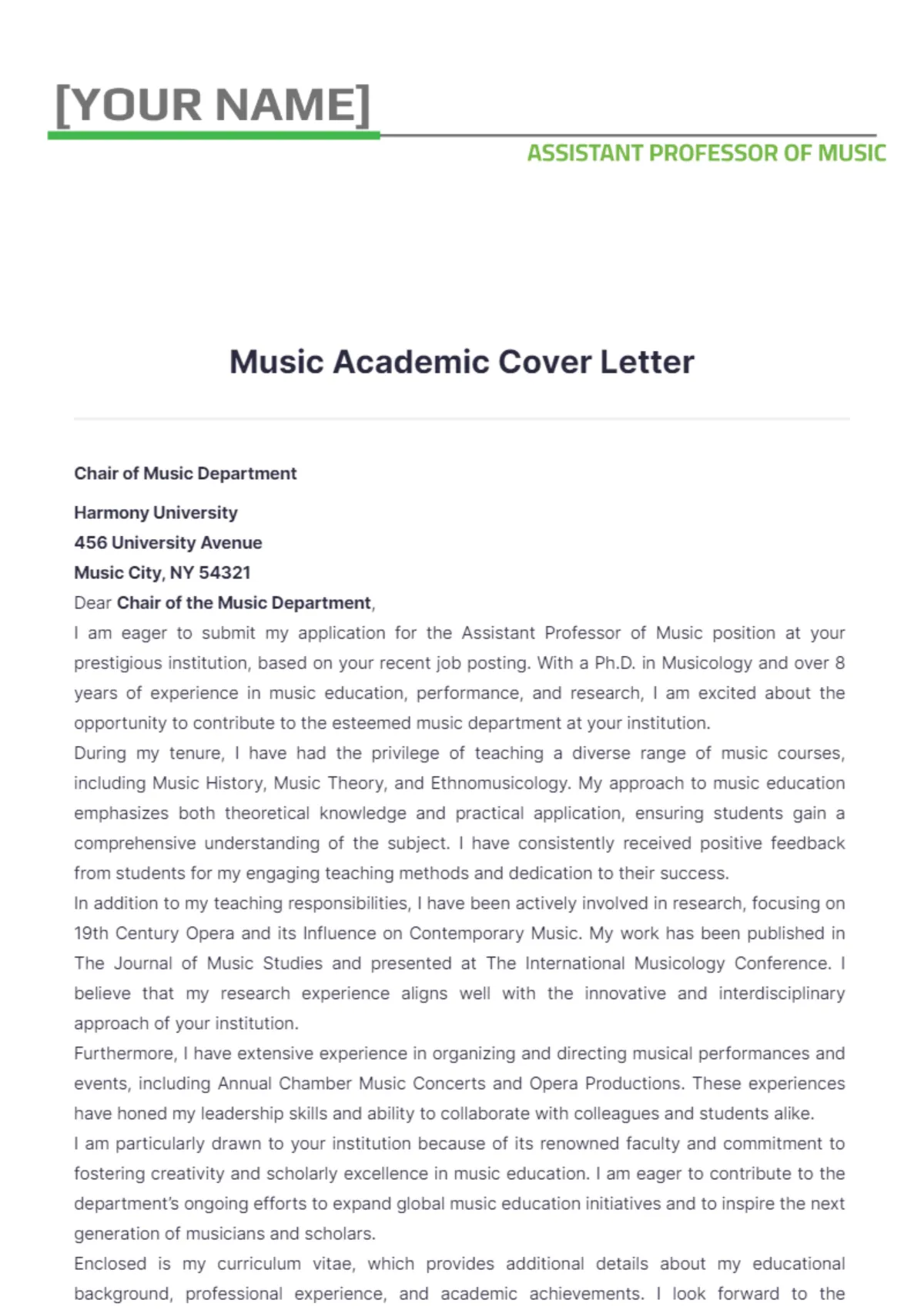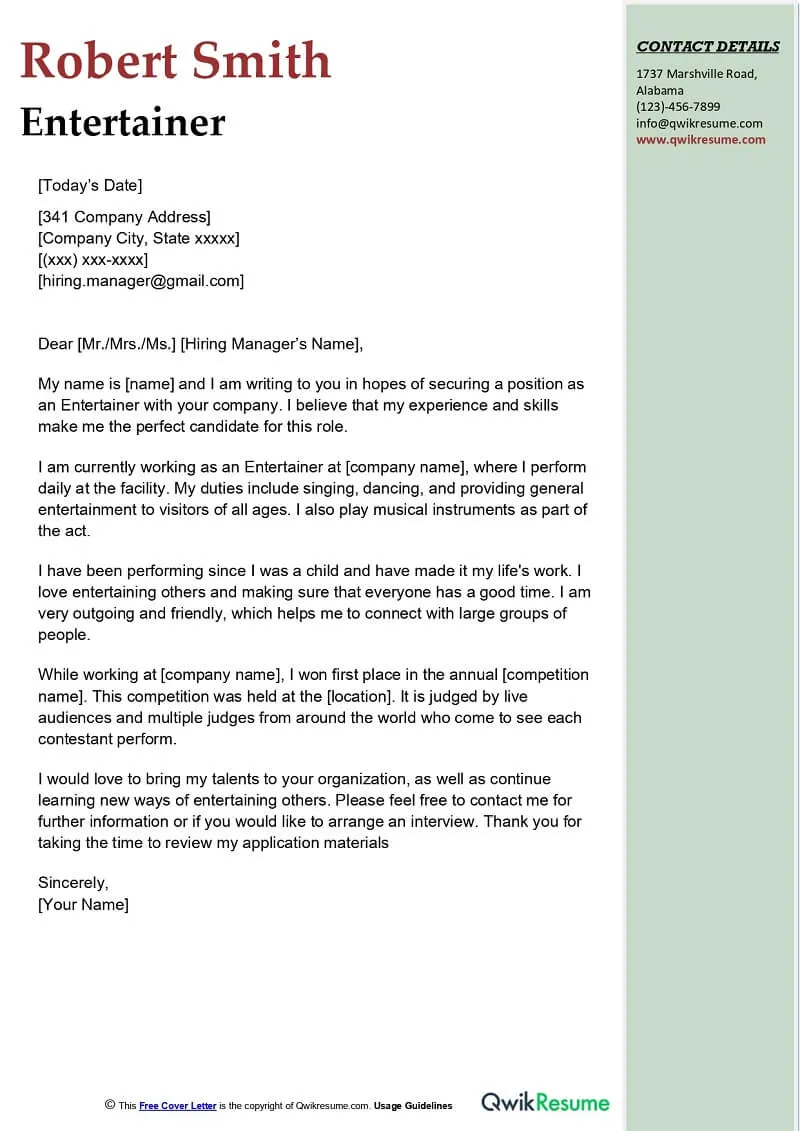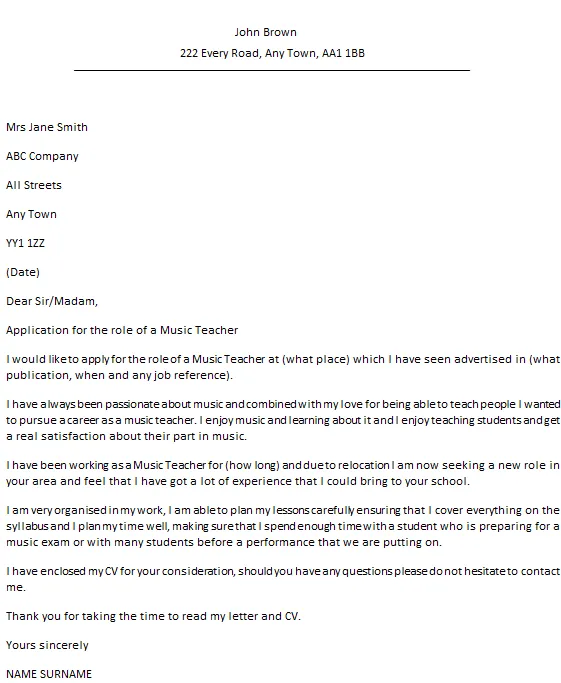Understanding the Importance of a Musicians Cover Letter
In the competitive world of music, where talent is abundant and opportunities are often scarce, a well-crafted musicians cover letter can be the crucial key that unlocks the door to your dream career. It’s not merely a formality; it’s your first impression, a chance to introduce yourself professionally, and a platform to showcase your unique skills, experiences, and passion for music. This document provides potential employers or collaborators with valuable insights into your personality, aspirations, and suitability for the role or project at hand. A cover letter acts as a personalized introduction, allowing you to go beyond the generic details found in your resume or portfolio. This guide will walk you through the essential elements of a compelling cover letter, ensuring you stand out from the crowd and increase your chances of success.
Why a Cover Letter Is Crucial for Musicians
While a resume or portfolio provides a snapshot of your qualifications, a cover letter offers the space to tell your story. It allows you to explain why you’re the perfect fit for a particular opportunity, demonstrating your understanding of the role and your genuine interest in the organization or individual. Furthermore, a cover letter showcases your communication skills, a vital asset in the music industry. It highlights your ability to articulate your ideas, express your enthusiasm, and convey your professionalism. Without a cover letter, you risk being perceived as another applicant, a statistic among many. A cover letter gives you the power to be remembered, to make a connection, and to present yourself as a dedicated and passionate musician ready to contribute to the world of music. It’s a chance to persuade, to sell yourself, and to make the recipient want to learn more about you.
Key Components of a Musicians Cover Letter

A compelling musicians cover letter is comprised of several key components, each playing a vital role in communicating your value proposition. These elements work together to create a cohesive and impactful narrative, from the initial greeting to the closing statement. A well-structured cover letter makes a positive first impression and provides a clear picture of your skills, experience, and passion for music. It’s important to remember that this document is a reflection of your professionalism and attention to detail. Each component should be carefully crafted and tailored to the specific opportunity to maximize your chances of success. Failing to address these elements adequately can undermine your application and make you appear less prepared or uninterested. By focusing on each section and presenting your best self, you can create a cover letter that grabs attention and sets you apart from the competition.
Contact Information Section
Begin your musicians cover letter with your contact information. This should include your full name, address, phone number, and email address. This information should be clearly displayed at the top of the document, usually aligned to the left or right. Ensure your email address is professional and appropriate. Avoid using nicknames or informal language. The contact information ensures that the recipient can easily reach you. This seemingly simple section is crucial. Imagine a hiring manager is impressed by your letter; without your contact details, they won’t be able to reach you! Accuracy is paramount. Double-check all information for any errors. Proofread it carefully to ensure that it is accurate and up-to-date. Consider including links to your online portfolio or professional website in this section to make it easy for potential employers to learn more about you. Your goal is to make it as effortless as possible for them to reach out.
The Introductory Paragraph
The introductory paragraph is your first opportunity to capture the reader’s attention. It sets the tone for the rest of the letter and should immediately communicate your purpose. Start by stating the specific position or opportunity you are applying for. Then, briefly introduce yourself, highlighting your most relevant skills and experiences. Show enthusiasm and make it clear why you are interested in the role and the organization. Avoid generic opening lines; instead, personalize your introduction to demonstrate that you have done your research and understand the requirements of the role. For example, if you are applying for a role in a specific band, mention your familiarity with their work. If you are applying to an orchestra, briefly mention your experience. The goal is to create a positive first impression, showing that you are a serious candidate and are excited about the opportunity. A strong opening sets the stage for a compelling narrative that showcases your value as a musician.
Highlighting Your Skills and Experience

The body of your musicians cover letter is where you showcase your skills and experience. Use this section to detail your musical training, performance experience, and any relevant accomplishments. Focus on the skills most relevant to the position or opportunity you are applying for. For example, if the role requires proficiency in a specific instrument, highlight your expertise and experience with it. If the role involves teaching or leading, mention any relevant experience and qualifications. Use specific examples to illustrate your skills and achievements. Instead of simply stating that you have experience performing in various ensembles, describe the types of ensembles and the roles you have played. Quantify your achievements whenever possible. For example, mention the number of concerts you have performed in, or the number of students you have taught. Tailor your content to the specific job requirements, demonstrating how your skills align with their needs. This will prove you’re a strong match for the role.
Showcasing Your Musical Achievements
In addition to your skills and experience, use the musicians cover letter to showcase your musical achievements. This could include awards, recognition, recordings, or performances. Highlighting these accomplishments will demonstrate your talent and dedication to your craft. Detail any awards or honors you have received, such as scholarships, competitions, or accolades from music organizations. List any recordings you have made, including the name of the project and the role you played. Mention any notable performances you have given, such as concerts, recitals, or collaborations with renowned musicians. Provide specific details about these achievements to make them more impactful. For example, if you won an award, describe the award and the competition in which you received it. The more specific you are, the more credibility you will lend to your claims. This section provides concrete evidence of your skills and capabilities, making you a more compelling candidate. Be sure to choose the most relevant achievements that align with the opportunity.
Tailoring Your Cover Letter to the Specific Opportunity
One of the most critical aspects of a successful musicians cover letter is tailoring it to the specific opportunity. Generic cover letters are easily recognized and often dismissed. Demonstrate that you’ve invested time and effort into understanding the role and the organization by personalizing your letter. Research the role requirements and highlight the skills and experiences that align with them. If the job description emphasizes specific instruments or musical genres, make sure to emphasize your experience in those areas. Research the organization or individual you are applying to. Learn about their mission, values, and recent projects. Refer to specific elements of their work that resonate with you. This could be a particular piece of music they have composed, a past performance, or their overall artistic vision. By tailoring your letter, you show that you are genuinely interested in the opportunity and that you have taken the time to understand their needs and preferences. This will increase your chances of getting noticed and making a positive impression.
Researching the Organization or Individual

Before writing your cover letter, research the organization or individual you are applying to. This will help you tailor your letter and demonstrate your interest in the role. Visit their website, read their mission statement, and learn about their recent projects. Familiarize yourself with their artistic vision and the types of music they create. If you are applying to an orchestra, learn about their repertoire and upcoming concerts. If you are applying to a music school, research their faculty and programs. This information will provide valuable insights that you can use to personalize your cover letter. Show that you understand their needs and how your skills and experience align with their requirements. This could include mentioning a specific piece of music they have performed or the accomplishments of their past alumni. Your research demonstrates that you are a serious candidate, and that you are invested in the opportunity. It also helps you identify common ground, enabling you to make a more genuine connection with the recipient.
Adapting to Different Music Genres and Roles
Your musicians cover letter should be adaptable to the specific music genre and role you are applying for. Tailor your language, tone, and focus to reflect the nature of the opportunity. For classical music roles, emphasize your formal training, technical skills, and experience with classical repertoire. Highlight your ability to work within an ensemble and your understanding of musical theory and history. For roles in pop or rock music, emphasize your stage presence, songwriting abilities, and experience with modern music production techniques. If you are applying for a teaching role, focus on your teaching experience, your ability to engage students, and your knowledge of music pedagogy. If you are applying for a position as a composer, showcase your compositional skills, your understanding of music notation, and your ability to write for various instruments and ensembles. Always tailor the tone and style of your letter to match the organization or individual. Use language and terminology that is appropriate for the music genre and role, and demonstrate your familiarity with its nuances.
Proofreading and Editing Your Musicians Cover Letter
Once you have written your musicians cover letter, proofread and edit it carefully. Errors in grammar, spelling, and punctuation can undermine your credibility and detract from your message. Read the letter aloud to catch any awkward phrasing or grammatical errors. Ask a friend, mentor, or career counselor to review your letter for feedback and suggestions. They can provide a fresh perspective and help you identify any areas for improvement. Pay close attention to the formatting of your letter. Ensure that it is easy to read and visually appealing. Use a professional font, consistent margins, and appropriate spacing. Before submitting your cover letter, review it one last time to make sure that it is free of errors and that it aligns with the job requirements. A well-written, error-free cover letter will show that you are professional and detail-oriented, increasing your chances of success. The quality of your writing will reflect your attention to detail and your overall commitment to your career.
Ensuring Clarity and Professionalism

Throughout your musicians cover letter, prioritize clarity and professionalism. Avoid using slang, jargon, or overly casual language. Write in a clear, concise manner, expressing your ideas directly and effectively. Use proper grammar, spelling, and punctuation. Maintain a professional tone throughout the letter, conveying respect and enthusiasm. Make sure your letter is easy to read. Use short paragraphs, clear headings, and bullet points to break up the text. Avoid using overly flowery language or clichés. Get straight to the point. The recipient should be able to understand your message at a glance. Demonstrate your knowledge and expertise. Be confident but not arrogant. Show that you are a professional who is serious about their music career. The best cover letters strike a balance between showcasing your personality and demonstrating your professionalism.
Formatting for Optimal Readability
The formatting of your musicians cover letter can significantly impact its readability and the overall impression it makes. Use a professional and easy-to-read font, such as Times New Roman, Arial, or Calibri. Choose a font size between 10 and 12 points. This ensures that the text is easily readable without being too small or too large. Use standard margins, typically one inch on all sides. These margins will provide a balanced look and make the letter easier to scan. Use single spacing within paragraphs and double spacing between paragraphs. This spacing enhances readability and prevents the letter from looking cluttered. Break up large blocks of text into smaller paragraphs. Short paragraphs make your cover letter more approachable. Use clear headings and subheadings to organize the content and highlight key information. This makes it easy for the recipient to quickly scan the letter and find the information they are looking for. A well-formatted cover letter shows that you are organized and that you pay attention to detail. This will enhance your chances of making a positive impression on the reader.
Finalizing and Submitting Your Application
Before submitting your musicians cover letter, take a final look to ensure that everything is in order. Double-check all the details, including your contact information, the recipient’s name and title, and the date. Proofread the letter one last time for any errors in grammar, spelling, or punctuation. Make sure that your resume or portfolio is up-to-date and that it aligns with the information in your cover letter. Ensure that you have followed the instructions for submitting your application. If the employer has specified a particular format or method for submitting your cover letter, be sure to follow their guidelines. After submitting your application, keep a copy of your cover letter and any supporting documents for your records. You may need to refer to them later. Also, consider sending a thank-you note to the recipient after an interview. This shows your appreciation for their time and reinforces your interest in the position. By following these steps, you can ensure that your application is polished, professional, and ready to impress.
